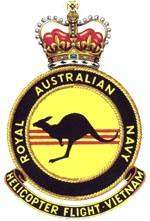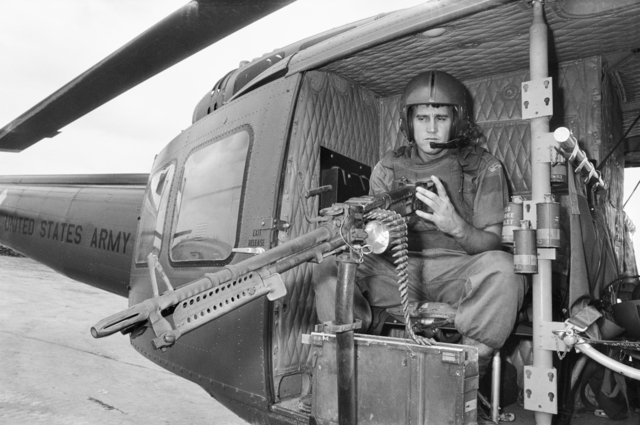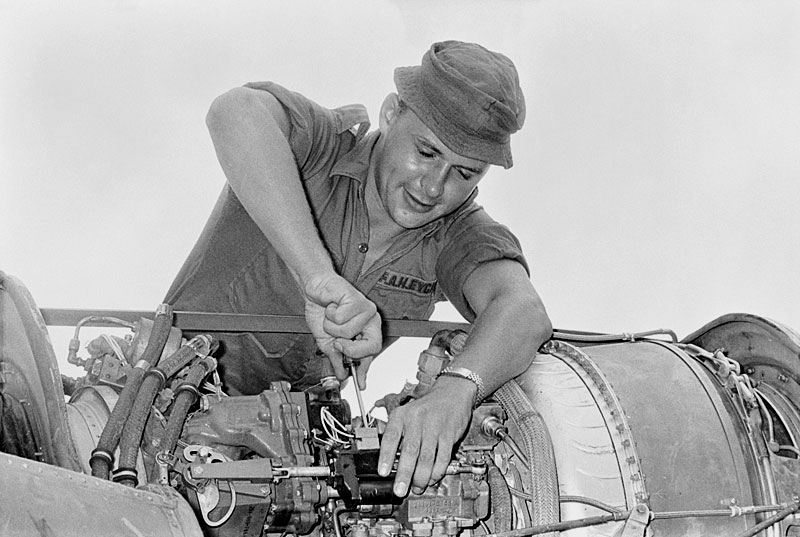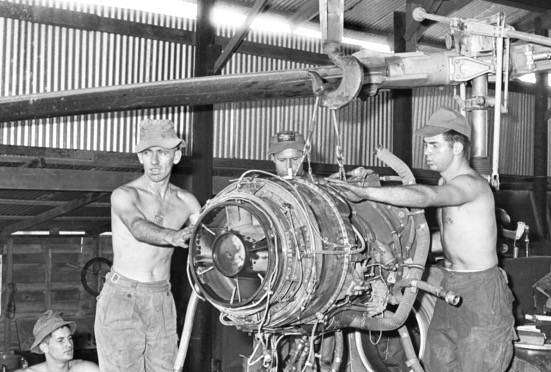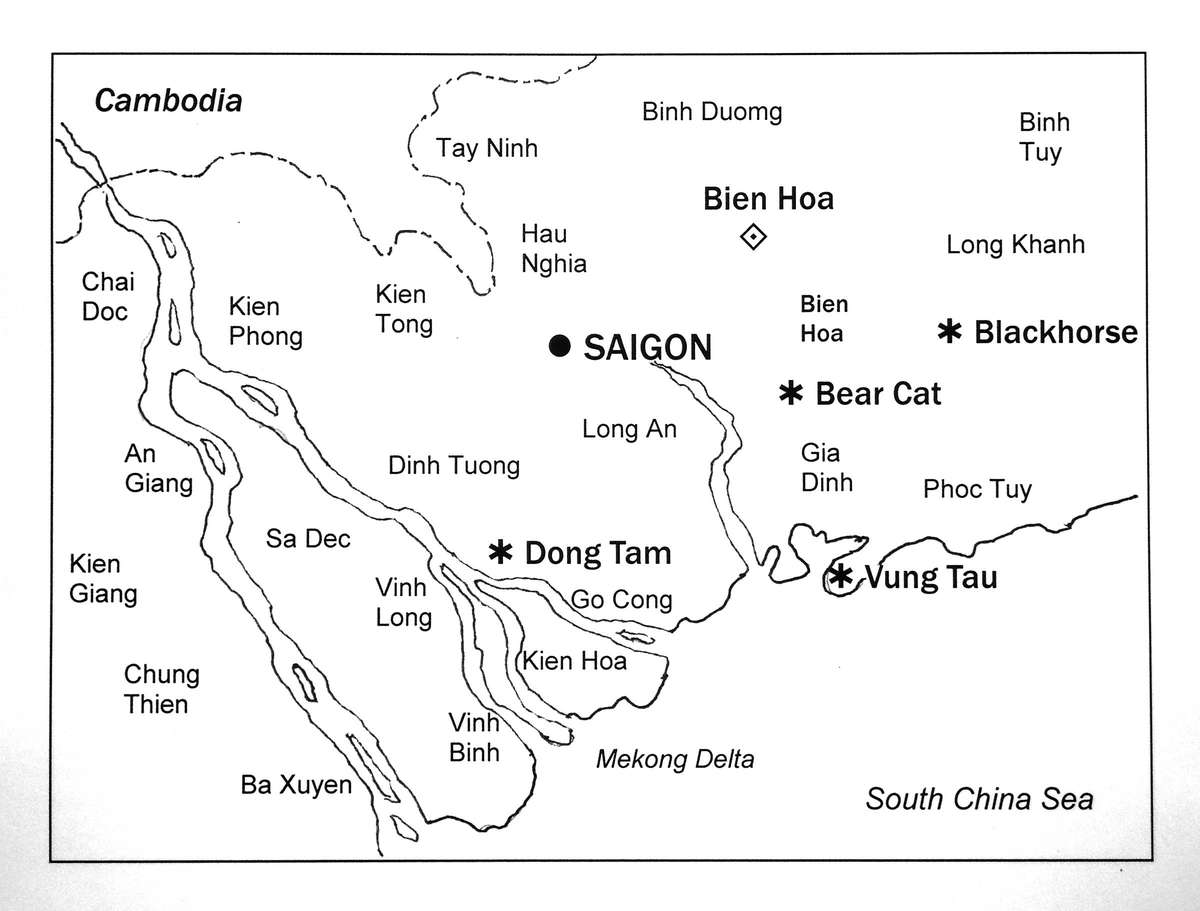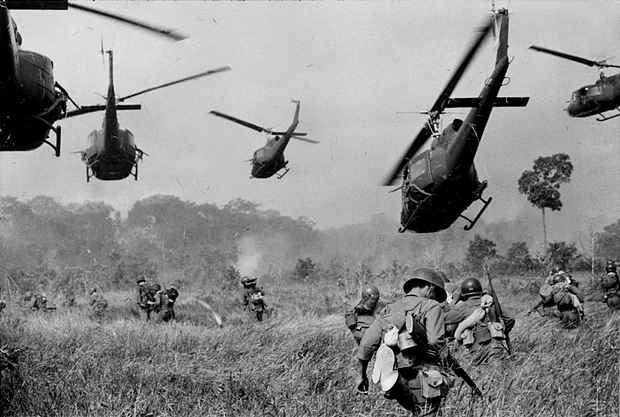
Photo: Horst Faas
The RAN HFV Story
Words by Kim Dunstan. Images courtesy of Australian Archives
The Royal Australian Navy played a significant role during the war in Vietnam, with some 13,500 personnel doing active service. HMAS Sydney is well remembered as the ‘Vung Tau Ferry’ completing 25 trips to Vietnam as a troop and transport carrier. RAN destroyers distinguished themselves carrying out gun-line duties off the coast. Clearance Divers did dangerous work keeping ships and harbours free from mines, and clearing estuaries and rivers of underwater obstacles and explosives. The escort vessels of the RAN and supply ships quietly and efficiently carried out their duties, likewise the logistic support teams, medical and humanitarian services.
A lesser known aspect of RAN service in the Vietnam War is the Royal Australian Navy Helicopter Flight Vietnam (RANHFV). Responding to a request for helicopter pilots, the RANHFV unit was formed in 1967 and integrated into the US Army 135th Assault Helicopter Company (AHC). The combined RANHFV/135th AHC group was called the Experimental Military Unit (EMU), flying variants of the Bell ‘Huey’ Iroquois helicopter. Their first role was to assist the 1st Australian Task Force at Nui Dat. When the RAAF took over that role the EMU was deployed to other areas.
From September 1967 to June 1971 the RAN sent four successive contingents of FAA pilots, observers, maintenance teams and support staff to Vietnam. Each group of 50 served a year before being replaced by the next – altogether around 200 served in the RANHFV. Fully integrated into the 135th AHC, their job was to fly air-mobile combat and supply missions with ‘Huey’ UH-1H ‘slick’ and UH-1C ‘gunship’ helicopters. Because of enemy activity in different provinces the EMU bases were moved from Vung Tau to Blackhorse, Bearcat, and then Dong Tam – all within 80 km of Saigon.
There are seven members of the RAN HFV whose whereabouts are unknown. Can you help locate them? More details here.
THE HUMAN ELEMENT
Nominal Rolls of those deployed
DID YOU KNOW?
Although only four contingents served in Vietnam, a 5th Flight was constituted (Mike Clarke CO desig) and was under training in preparation for deployment later in 1971. It was disbanded beforehand, however, as the Government of the day withdrew Australian forces from the conflict earlier than expected. A photograph of (most of) those who would have served on the RANHFV 5 can be seen here.
Reflecting an upbeat approach the EMU motto was ‘Get the bloody job done.’ The primary role was transporting infantry troops, supplies and equipment; search and rescue work; night hunter-killer patrols and Medivac flights. The EMU’s key task was providing helicopter transport and gunship air-support for combat troops attacking VC strongholds; initially for the Australian Army (RAR), then the Army of the Republic of Vietnam, United States Army and Marine Corps. These were hazardous operations against well-armed Viet Cong guerrillas and North Vietnamese soldiers.
The RANHFV pilots and aircrewmen were in the thick of some of the most intense battles experienced by Australians in Vietnam – operating missions that placed great strain on man and machine. For the aircrew, a mission meant rising at 4.30 am, departing at dawn for the day’s flying, which could last 12 hours or more; this frequently involved inserting infantry troops into ‘hot’ landing zones.
Maintenance and technical crews together with other support staff all worked long hours. The RANHFV personnel set a high standard gaining a reputation second to none.
Troop transport and cargo-lift ‘Huey’ helicopters were called ‘slicks’ because of their uncluttered appearance. They were the UH-1H type, powered by a T53-L-13 turbo-shaft engine, with a stretched cabin taking 10 + passengers; crew 2 pilots and door gunners either side with 7.62mm M60Ds providing covering fire for troops; external cargo 4,000 lb. The UH-1C was specifically designed as a ‘gunship’ using a T53-L-11 engine, and modified rotor blades for improved performance and speed; crew 2 pilots and door gunners with M60s; plus external mounted mini-guns & rocket pods. The gunships equipped with the M5 40mm grenade launcher were called ‘Hogs’. Generally EMU ‘gunships’ were called ‘Taipans’ after the deadly Australian snake.
 A UH-1C ‘gunship’ fires rockets into a VC trouble spot.
A UH-1C ‘gunship’ fires rockets into a VC trouble spot.
The Mekong Delta was the focus for many combat missions. Depending upon the task, it could mean inserting 100 infantry or more into a ‘hot’ landing zone (LZ); then bringing in more troops; recovering downed crews; doing medivacs, then extracting troops at the end of the day. A typical insertion involved a command helicopter flying above with 10 troop-carrying ‘slicks’ and 2 to 4 UH-1C ‘gunships’. Firstly, where possible, artillery would be fired into the landing zone; ‘gunships’ would ‘prep’ the area with machine guns and rockets for several minutes, the ‘slicks’ would then land and discharge troops, with door gunners providing covering fire in a ‘hot’ LZ. Dangerous and intense there was no letup until the job was done.
A RANHFV door gunner with a M60D machine gun at the ready, with smoke canisters on the cabin pillar
On return to base night-shift maintenance crews would work all night repairing battle damage and carrying out minor repairs, often in torchlight, ensuring the required number of helicopters were ready for the next days commitments. Door gunners, selected from the maintenance crews, would load rocket pods, mini-guns and check the M60 machine guns and ammunition requirements – then it would start all over again. Day-shift maintenance crews carried most major repairs and routine maintenance, thoroughly checking engines, airframes and rotor blades for damage; generally out in the open in basic conditions – the pressure was always on. Apart from the hazardous flying the climate in Vietnam was extremely trying, ranging from hot and dusty in the dry season to hot, humid and muddy in the wet season.
On arrival in Vietnam the RANHFV aircrews quickly became operational. Initially trained to fly helicopters in anti-submarine warfare, the RAN aircrews and maintenance teams were required to learn new skill-sets before arriving in Vietnam. This included intensive combat flying; coming under enemy fire; living in remote camps subject to Viet Cong rocket and mortar attacks and boundary skirmishes; learning the best way to insert troops and extract them from dangerous landing zones; knowing the survival techniques in the event of a forced landing in enemy territory, weapons training and more. The fact this change-over was conducted quickly and efficiently is a testimony to the dedication and professionalism of the RANHFV teams.
Above: South Vietnam. June 1971. An Army toast to aircrew of the Royal Australian Navy Helicopter Flight after their last operation in South Vietnam. Australian Army Training Team Vietnam (AATTV) member, Warrant Officer Class 2 (WO2) Lee McIntosh (right), proposes a toast with champagne to Navy pilots beside a helicopter. Left to right: Sub Lieutenant Jim Gumley; Lieutenant Rod Coles; Lieutenant Brian Abraham, and Sub Lieutenant Bill Shurey. (Aust.War Memorial).
Following the announcement by the US Government of its policy of disengagement, with the responsibility for defence passed to the South Vietnamese. On 8 June 1971 after 4-years of joint combat activities with the US Army 135th AHC the war came to an end for the RANHFV. Packing-up commenced immediately with departure for Australia set for 16 June 1971. The success of the joint EMU operation has been a great source of pride for the 135th AHC and RAN. The RANHFV crews including support staff of photographers, stewards, cooks, writers, storemen, and sick-berth attendants all earned the respect and admiration of the various services they worked with.
During 4-years of flying hundreds of combat operations in Vietnam, the RANHFV earned 3 MBEs, 8 DSCs, 5 DFCs, one BEM, 24 MIDs and 34 Naval Board Commendations. 723 Squadron the parent unit of the RANHFV was awarded the battle honour ‘Vietnam 1967-71’. In addition 8 RAN helicopter pilots flew with 9 Squadron RAAF. RANHFV casualties were: 5 were killed; 10 seriously injured, others received wounds of various types.
On 01 June 2018, the Minister for Defence Personnel, the Hon Darren Chester MP, announced that the extraordinary gallantry displayed by the RANHFV, drawn from 723 Squadron, would be recognised by a Unit Citation for Gallantry. On 18 August 2018 the presentation of the award was conducted at Canberra, by the Governor General of Australia, His Excellency General the Honourable Sir Peter Cosgrove AK MC (Retd.), in the presence of former members of the RANHFV and the Hon Darren Chester MP.
From the 1920s communists were active in French Indo-China indoctrinating the rural population, creating cells in cities and towns, exploiting the frustrations with the feudal system of government and powerful French colonial administration. Following the Japanese occupation 1942 the communist led Viet Minh began fighting and at the end of WW11 when the French returned – they defeated them at Dien Bien Phu in 1954. Following the Geneva Peace Treaty which divided Vietnam in two at the 17th Parallel, the communist government in the north, who openly backed the Viet Cong, began the process of eliminating opposition in the south through terrorism and assassination. Ruthless and determined Viet Cong guerrillas, armed with Soviet weapons raided villages and towns, attacking and murdering government officials (mayors, police, post office workers, teachers, etc.- some 37,000 were assassinated). Reinforced by well established supply lines and North Vietnam soldiers the communists gained a strong hold on the South Vietnamese countryside. Well armed and highly organised the communists kept up the pressure using terrorist tactics and coordinated attacks against major centres. Across the world the war of words raged, as anti-war propaganda took hold the weight of opinion changed. An important factor is that war is a contest of wills. When support at home is lost so is the battle. Nixon thought the 1972 Paris Peace Agreement would bring peace with honour, but that was an illusion as soon after the North moved-in and 2-years later it was all over when Saigon fell. The huge number of Vietnamese who fled the country speaks volumes about the communists and their methods.
DEFINITIVE VIETNAM CONFLICT INFORMATION
An exhaustive and detailed reference of the Vietnam conflict and all factors pertaining to it can be found here.
VETERANS & VETERANS’ FAMILIES COUNSELLING SERVICE
VVCS provides free, confidential counselling and group program services to veterans of any conflict, and their families. Find full details here.

